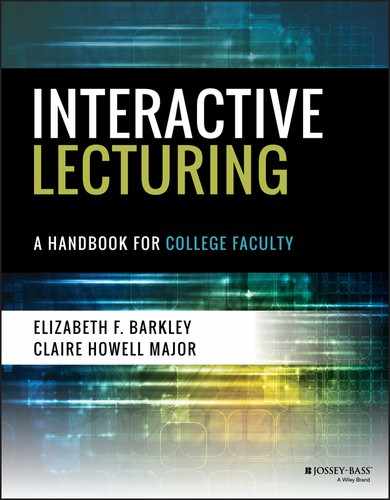ENGAGING LECTURE TIP 5
Sticky Note Diagrams
Sticky Note Diagrams enable you to generate and then organize a large number of ideas into their natural relationships. Similar to an affinity grouping, which is done in groups (see Barkley Major, & Cross, 2014), Sticky Note Diagrams are completed by individuals. When applied to preparing for a lecture presentation, this approach can be a powerful method not only for producing and capturing ideas but also for managing and making sense of a large body of facts or concepts. Sticky Note Diagrams help individuals discover previously unseen connections that link common things of a group together, thereby understanding information in new ways. It can also be effective for seeing the “forest in the trees.” Thus it is useful when issues seem too large and complex to fully grasp or, alternately, when seemingly countless facts or ideas result in apparent chaos. Sticky Note Diagramming involves generating ideas for the lecture, identifying common themes among the ideas, and then sorting and organizing the ideas and themes accordingly in ways that can make the content more accessible for students.
To work through the process of Sticky Note Diagrams you will need the following materials: sticky notes or index cards, pens or pencils, and a large surface to work on, such as a wall, table, or floor. Sticky Note Diagrams have four main phases: idea generation, idea sorting, idea selection and discarding, and idea group labeling.
- Idea generation. Think of as many ideas as possible related to the lecture content, expressing each idea in a single word or a short phrase that you write on a separate sticky note or card.
- Idea sorting. Randomly spread notes on the work surface so that all of the notes are visible. Next, look for ways to group the individual notes. Start small, selecting just two ideas that seem to be related in some way and then placing the sticky notes side by side. Repeat the matching process, grouping several notes together into a pile. The purpose is to engage in a process of constant comparison of ideas to look for association, kinship, or likeness, all of which are synonymous with affinity. The grouping continues until you have placed all of the notes in their appropriate spots. (It's okay to have loners that don't seem to fit a group. You can decide in the next step if these are critical parts of the content.)
- Idea selection and discarding. Instructors have a tendency to include everything and to be reluctant to discard favorite details. However, research shows that having too many details can be distracting for students and can harm their learning. When you have created groups, it is easy to see which ideas are the most central—they are the ones that have the most sticky notes. Consider keeping those and discarding piles with very few notes.
- Idea group labeling. Select a heading for each group by looking for a note in each grouping that captures the meaning of the group. If no such note exists, write one. When you have found an appropriate title for the collection, place it at the top of the group. Some shifting of notes during this phase is common, so recombine note groupings as appropriate. The notes might look something like that shown in Figure 4.1.

Figure 4.1 Idea Group Labeling Example
Although as described this technique involves physically handling the ideas, there are several online mind-mapping and note-taking tools that can make doing this technique directly on a computer an option, such as Memosort, Popplet, and Bubbl.us. You could also use the Smart Art graphic tool in Word or PowerPoint.
Example
Key References and Resources
- Barkley, E. F., Major, C. H., & Cross, K. P. (2014). CoLT 19 affinity grouping. Collaborative learning techniques: A handbook for college faculty. San Francisco, CA: Jossey-Bass.
- Brassard, M. (1989). The memory jogger II. Methuen, MA: Goal/QPC Press.
- King, R. (1989). Hoshin planning: The developmental approach. Methuen, MA: Goal/QPC Press.
